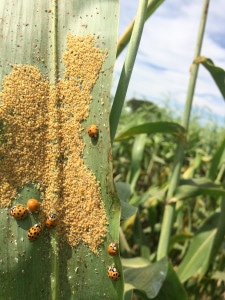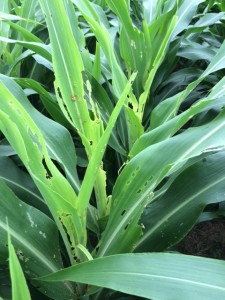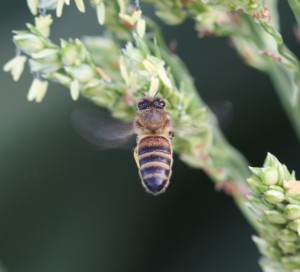Sugarcane aphids have now been confirmed in Shelby County. The good news is that populations are very low at this time, and it seems to me that we are on a similar schedule as last year. Thus, I’m hoping that much of the early grain sorghum will be at low risk to serious infestations. The bad news is we seem to be on a similar schedule to last year, and we should anticipate that at least our later planted sorghum might eventually require treatment for this pest. Treatment level infestations are occurring in southern Arkansas, central Mississippi and across central Alabama and Georgia (and of course areas further south). Sugarcane will likely continue to progress northward, and our later planted milo will need to be scouted closely. Folks in the southern counties of Tennessee need to be especially alert for infestations. Thinking ahead, let me remind you of a few points that I’ve made in previous articles.
- Pyrethroid insecticides can flare infestations of sugarcane aphid by wiping out beneficial insects, so don’t make unnecessary applications for sorghum midge and other pests. Please refer to my previous article for suggestions on managing sorghum midge … and insecticide selection when both midges and sugarcane aphids are threatening.
- Treat when aphids are present on 30-50% or more of plants and occasional leaves have 100 or more aphids present. Treatment should also be considered if honeydew is present in multiple spots in a field. Collectively, we are still working out the best treatment thresholds, but don’t wait to make an insecticide application when aphids are easy to find on most plants.
- Infestations are often worst first on field edges. There MAY be some opportunity for edge treating on some occasions, but you better be “Johnny on the spot”. I suggest scouting every 4-5 days once sugarcane aphids show up in the field at anything other then very low numbers. Things can happen quickly with this critter.
- The only two products I would recommend specifically for controlling sugarcane aphids are Transform or Sivanto. Tennessee has an emergency use exemption (Section 18) for the use of Transform WG (1.0-1.5 oz/a) for sugarcane aphid control in sorghum. Sivanto is a newly registered insecticide from Bayer CropScience. It showed encouraging results in 2014 at the lower and more affordable rates found on the 2ee label (4-7 oz/acre). Sivanto has not been extensively tested at these rates, but reports from further south indicate generally good results this year.
- One insecticide application may not be enough. Some late planted fields required two applications in 2014. This is likley if populations are high at the time of the first application.

Corn leaf aphid and the sugarcane aphid are the only two species you are likely to see on mid and upper canopy leaves in clusters of 100 or more aphids. Thus, big clusters of pale yellow to yellow colored aphids (pictured right) found on the undersides of sorghum leaves is a pretty good sign you are dealing with sugarcane aphids. Corn leaf aphids are green.
The yellow sugarcane aphid (click for pictures) is a different species that may also be present, usually in smaller numbers and smaller clusters. This aphid is brighter yellow. Its body is covered with little hairs that are visible with a 10X hand lens. Get some help if identification is in doubt.
 I’m getting a number of calls about fall armyworms and corn earworms in the whorls. The picture to the right was sent by a client. Although the feeding looks terrible, sorghum can tolerate a lot of leaf feeding injury. The suggested threshold for treatment is an average of 0.75-1.0 larvae per plant. It would be rare for this to occur except for fall armyworm on later planted sorghum. I might be more aggressive on small sorghum (< 4-5 leaves), but the point is not to get too excited about whorl feeding caterpillars. If treatment is justified, lean towards products like Prevathon, Besiege, and Belt. Pyrethroid insecticides will be marginally effective at best.
I’m getting a number of calls about fall armyworms and corn earworms in the whorls. The picture to the right was sent by a client. Although the feeding looks terrible, sorghum can tolerate a lot of leaf feeding injury. The suggested threshold for treatment is an average of 0.75-1.0 larvae per plant. It would be rare for this to occur except for fall armyworm on later planted sorghum. I might be more aggressive on small sorghum (< 4-5 leaves), but the point is not to get too excited about whorl feeding caterpillars. If treatment is justified, lean towards products like Prevathon, Besiege, and Belt. Pyrethroid insecticides will be marginally effective at best.
 Honey bees love to forage in flowering sorghum. Given the microscope we in agriculture are under concerning pesticide effects on pollinators, think about pollinators when making pesticide applications in sorghum. Bees will be most active between 9 AM – 6 PM. If possible, make insecticide applications later in the day. This is especially important if managed bee hive are located within 1-2 miles of the field. This is another reason not to spray for sorghum midge unless necessary.
Honey bees love to forage in flowering sorghum. Given the microscope we in agriculture are under concerning pesticide effects on pollinators, think about pollinators when making pesticide applications in sorghum. Bees will be most active between 9 AM – 6 PM. If possible, make insecticide applications later in the day. This is especially important if managed bee hive are located within 1-2 miles of the field. This is another reason not to spray for sorghum midge unless necessary.



One thought on “Sugarcane aphids, whorl-feeding caterpillars, and bees in sorghum”
Comments are closed.